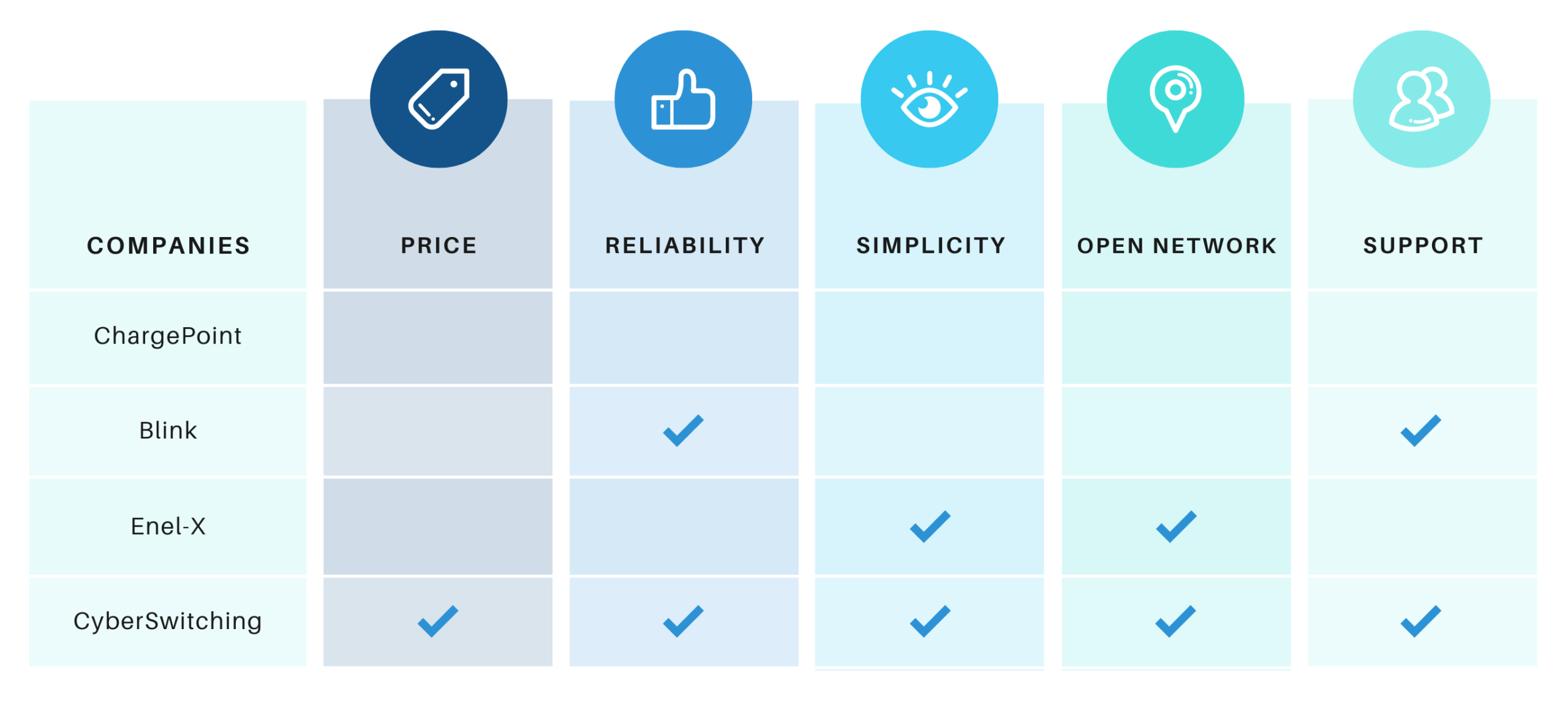
Home / EV Charging News / Electric Vehicle charging in Apartment Buildings: Challenges, Alternatives, and Solutions

Electric Vehicles (EVs) are a sustainable and energy-efficient mobility option that reduces carbon footprint. Owning an EV can be great for your economy and the environment, but the national EV charging infrastructure still has a long way to go, which is why apartment electric car charging can be an important challenge to overcome.
In this article, we address some challenges and solutions for EV charging in apartments which will help you to successfully find ways to charge your EV. They can be of great help no matter the type of apartment building or the number and type of EV chargers available in it.
Installing electric car apartment charging can be one of the most beneficial features for a building. Today there are over 1.7 million EVs on U.S. roads, representing an increase of 325% from 2018, but this number is expected to grow to as much as 26 million by 2030, quite a surprising feat.
While the U.S. government is planning to increase the EV charging infrastructure in the following years, the amount invested and the number of chargers that will be installed may be far from enough. A suitable solution for this problem is the installation of apartment EV charging, which is becoming a highly attractive feature already present in a few selected buildings.
Buildings with electric car charging solutions for apartments can generate a passive income thanks to the EV chargers, they can also improve the quality of the tenants in the building, increase the reputation and branding of the building, and more. To achieve this, building owners should work with their current tenants to assess their charging needs and analyze how this amenity can be used to attract new tenants.
It is important to consider certain aspects when installing EV charging apartment buildings. Some important ones include the electrical capacity of the building, the number of tenants in the building with EVs, the available budget for the investment, expected profit, and others. During this article you will find valuable information to help building owners and tenants obtain EV charging in apartments.
Learning how to charge an electric car at an apartment building can be quite easy for tenants since the process is similar or the same as in regular public EV charging stations. The steps to learn how to charge an electric car at an apartment building are the following:
Charging an EV can be easily done in 5 simple steps, the only aspect that may vary is how the charge is billed, the app used to charge the EV, and a few other details. When no EV charger is available in the apartment building the challenges become numerous, but there are some alternatives that we will analyze further on, including finding nearby charging stations, running a heavy-duty extension cord to your EV, finding the right apartment, asking the landlord for the installation of EV charging stalls, and others.
Electric car charging at apartments may be a little more difficult than doing EV charging in a household where you can take completely independent decisions over your house infrastructure. Let us check on some of the typical challenges that restrict electric car charging in apartment blocks:
Electric vehicle charging in apartment buildings can be extremely hard if there are no EV chargers installed. Some forward-thinking apartment building councils may plan to install an apartment EV charging station in available parking spaces, but this can prove a challenging task in some buildings, especially old ones with low electrical capacity available.
The main available option for electric car apartment charging is using Level 1 Chargers with traditional 120V outlets, but this takes up to 50 hours to charge EV batteries. There are a few interesting and innovative solutions that will make electric car charging in apartment blocks easier, however, they present some challenges that you need to watch out for. Some alternatives you may consider are the following:
One solution for EV apartment charging is finding a DC Fast Charger (DCFC) station or supercharging station near your home. You can charge your EV in around 1 hour at these locations. To find the nearest DCFC Station you can install EV Charging Station Finder apps like OpenChargeMap, ChargeMap, Electrify America, Chargeway, PlugShare, or ChargeHub.
Another alternative to EV charging at your apartment is charging the vehicle at your workplace instead. Many office buildings are joining the e-Mobility revolution by installing EV charging Stations at the workplace, these feature Level 2 EV Chargers and can fully charge EV batteries in around 4 to 10 hours. If your workplace does not feature EV Charging Stations, you can be the force of change and promote the idea.
Desperate situations require desperate measures, but it is important to always be careful. Running a heavy-duty extension cord from your apartment to your EV might be an alternative solution for EV charging in apartment buildings. However, you must keep in mind that this could only be applied in low-rise buildings or buildings with just a few stories (3 or 4 maybe). This would also need to be confirmed with the corresponding apartment building board for permission.
Technically, you can do this for Level 1 EV Chargers with 120V outlets or a 240V connection with a Level 2 residential charger, but this is not always recommended. Using an extension cord to charge an EV increases the risks of electric shocks and electrical fires, on top of increasing the chance of voltage drops, which can reduce the performance or even endanger the EV charger equipment.
Moving to an apartment with EV charging is a sweet solution to your problems. Forward-thinking apartment councils have installed EV Charging Stations at the parking garage to suit the needs of current and future EV owners in the building or are currently planning on doing so.
Apartments with charging stations are more attractive to tenants. These buildings can become more attractive since they provide an elegant and futuristic look to the complex while at the same time sending a message that people living there are concerned about the environment.
Asking the landlord or HOA of a building could be a last resource option for charging your EV in an apartment. This would represent a considerable investment, which is why you should consider all possible challenges and come up with solutions beforehand to have a stronger case. Some challenges to address might be the following:
Charging an EV in your apartment building is an amenity that will increase the value of the property and therefore the rent cost, but some landlords might still be reluctant to the idea. You could consider pitching in alongside other EV owners to partially or completely pay for the installation and explain the profits of installing EV charging stations for apartments.
As for scheduling, if the EV charging at the apartment building will be installed privately for certain apartments in particular then there is no issue at all. However, scheduling EV charging for apartments (considering the EV charger as an amenity of the apartment complex) can be challenging as some tenants might leave their vehicles plugged in all night with a full battery. Applying a fine or setting hourly fees could be an incentive motivating owners to connect the vehicles and move them after they are charged. Enabling charging reservations ahead can also be a solution for this.
Finally, while some new, luxurious, or modern apartment complexes will find it attractive to add EV charging, landlords in medium or low-rent cost buildings may not be up to the idea for different reasons. While it is expected eventually that there will be more EVs than gasoline vehicles in the future, some landlords may not be prepared or interested in investing to upgrade an apartment with electric car charging. In this case, the best is to negotiate with your landlord to see if you can carry on the electric car charger apartment installation for a private stall in your parking spot.
There are many benefits if you decide to install an electric car charger in an apartment building. For tenants the main benefit is the ability to charge an EV in their apartment building, while building owners will benefit from the additional profits, the increased added property value, and more. In this section, we explain the most important ones.
A great benefit of installing electric car charging for apartments is the possibility to attract the right type of tenants that elevate the reputation of the building and the rent price. EV owners are more economically affluent and tend to be better educated, attracting tenants with these features as a result of installing electric car charging in an apartment building can succeed whether you are trying to attract a more sophisticated public to your building or to increase the price of rent for profits.
Just like the quality of the tenants in your building can increase thanks to electric car charging in apartments, so does the time they remain there. This increased tenant retention is the result of only a limited number of buildings offering charging electric cars in apartments at the moment, this can financially benefit building owners since it is cheaper to renew a lease than to sign new tenants.
One of the most important benefits achieved by installing electric car charging stations in apartments is the passive income for building owners. It is estimated that a single EV charger in 2023 can make on average a little less than $2,000, however, by 2027 a single EV charger will be making around $2,800, meaning the passive income of the building will increase as the years go by.
Apartment buildings with EV charging stand out from the rest by offering one of the most coveted and beneficial features available. The exclusive amenity of electric car charging at apartments will surely improve the reputation of a building, generating a more prestigious air to it and adding the possibility of increasing rent with no repercussions, since tenants are more lenient to spend extra money on the feature.
The current tenants of a building are the first ones that will use and experiment with the EV charging station in an apartment building, which is why building owners should consider their needs first. This includes the type of vehicle they have, the required charger plug, the power required to fully charge the battery in a few hours, and the available budget for EV charging. Working with current tenants ensures future tenants are more attracted to your apartment building, increasing the success of this project.
To ensure current and potential tenants learn about the possibility of EV apartment charging in your building, you should promote the feature. Promoting apartments with EV charging can be the game changer to attract more and better tenants, but also to increase profits and retain current tenants.
When installing electric vehicle charging in apartment buildings, building owners should optimize profit by setting the right plan. This plan includes determining a billing system for EV charging for apartments (per usage or monthly bill), charging type (per kWh or session), and figuring out any other detail. If possible you should also determine a fair cost to charge vehicles in the building, since some tenants might be lenient to pay extra, but charging too much may scare them away.
Some building owners may complicate themselves with the details, but electric vehicle charging in apartments is designed to be easy and simple. The whole process can be operated and optimized with energy management software, granting building owners full control over the EV charging station at all times, providing the right logistics, and improving power usage for each charger. Tools such as the EVMC make it easy to manage multiple EV chargers at the same time and optimize costs.
EV enthusiasts should always analyze their whole scenario before buying an EV, this will help them properly asses their action plan regarding EV charging. If you currently live in a building with suitable EV charging stalls, then you can surely acquire your vehicle and carry on, however, if you do not have access to charging an electric car at an apartment building, we recommend talking to your landlord or building owner to promote the whole thing.
Explaining the whole situation might make landlords consider EV charging since they will get numerous benefits from this, while you get access to EV charging in your building. Another option is simply planning your daily commute including spending a few hours a week at an EV charging station or asking permission to install an EV charger exclusively for you in your parking lot.
Granting tenants the possibility of electric vehicle charging in apartments will not only deliver benefits to them but also to the owners of the apartments and buildings. The following list shows the benefits of buildings with installed EV Charging stations:
These are some of the most important benefits of car charging stations for apartment buildings. EV charging stations are beneficial for landlords, tenants, and even for the building community in general.
Can You Install an EV Charger in Your Apartment Building?
Yes, it is possible to install an EV charger at your apartment building as long as you have permission from the building owner or the building council. The only problem is that you may have to carry the expenses if they are not willing to invest.
Is Community Charging Suitable for Apartment Buildings?
Community charging is a great option for an apartment building. Building owners can install commercial-grade community EV charging in apartment buildings, operated by external software. This investment is profitable and beneficial both for tenants and building owners.
Can EV Owners Simply Plug Level 1 EV Chargers in the Wall Socket Next to Their EV?
If your parking spot is next to a wall socket, you might consider simply plugging your charger, but this may not be as easy as it sounds. For electric vehicle charging stations for apartments, you should check with building owners if the circuit is rated for EV charging and determine how to measure the power you consume to pay for it since otherwise, the whole building would be paying for it.

CSE1 EV charger on pedestal
CSE1 EV Charger, wall mount
CSE1 Dual EV charging station

Your Power Management Partner for Over 25 Years Future Generations Depend on Our Decisions Today ™
2024 © All rights reserved by CyberSwitching